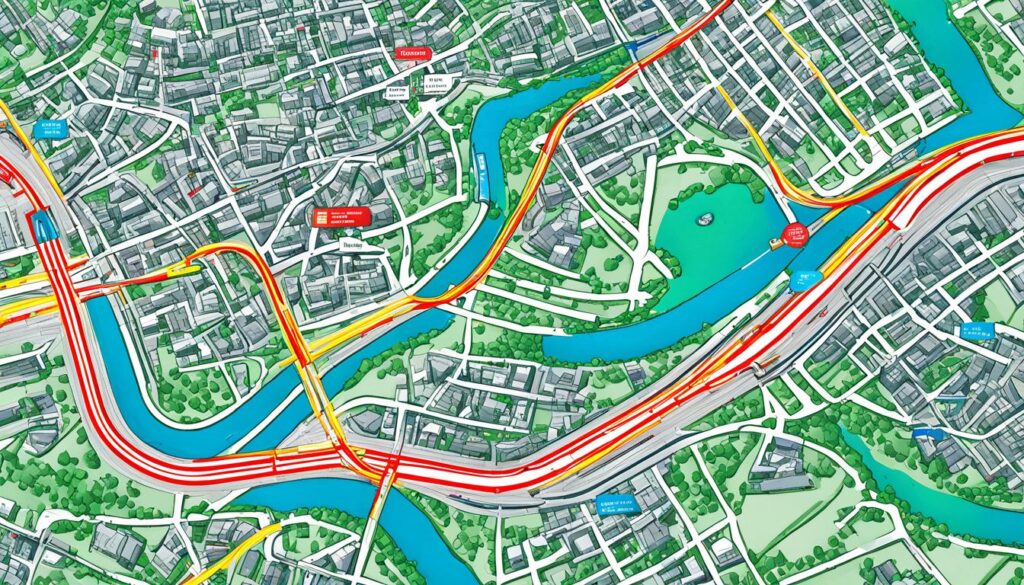
Geospatial technology, also known as geographic information technology, is a diverse range of tools and systems used to map, analyze, and interpret spatial data related to the Earth’s surface and human societies. This technology has evolved significantly over time, from traditional methods such as aerial photography to advanced techniques like satellite imagery and computer-based systems.
Key Takeaways:
- Geospatial technology encompasses various tools for mapping and analyzing spatial data.
- It includes technologies like remote sensing, GIS, GPS, and internet mapping.
- Geographic Information System (GIS) is widely used in industries such as engineering, conservation, agriculture, and humanitarian relief.
- This technology has revolutionized decision-making processes and improved efficiency in various sectors.
- Advancements in geospatial technology continue to shape our understanding of the world and inform important decisions.
Evolution of Geospatial Technologies
The history of geospatial technology dates back to prehistoric times when the first maps were drawn. Over the centuries, advancements in technology have shaped the development of geospatial tools and systems. A notable breakthrough came in the 19th century with the introduction of aerial photography, revolutionizing cartography by providing a new perspective on the Earth’s surface.
However, it was during the Second World War and the subsequent Cold War that Geographic Information System (GIS) advanced at an accelerated pace. The combination of satellite technology and computers propelled the science and art of photographic interpretation and map making to new heights.
Today, geospatial technologies have significantly evolved to encompass a wide array of tools and platforms. A network of satellites enables precise global positioning, while powerful desktop Geographic Information Systems (GIS) allows for advanced data analysis and visualization. Aerial remote sensing platforms provide high-resolution imagery, and internet mapping technologies make geospatial data accessible to users worldwide.
These advancements have not only enhanced the capabilities of geospatial technology but have also made high-quality hardware and data more accessible to various entities, such as universities, corporations, and non-governmental organizations.
With each new development, Geographic Information System (GIS) continues to push the boundaries of what is possible, shaping the way we map and analyze our world. The next sections will explore the diverse applications of Geographic Information System (GIS) across industries and the importance of this technology in decision-making processes.
Applications of Geospatial Technology
Geospatial technology has revolutionized various industries, offering a multitude of applications that drive efficiency, decision-making, and resource optimization. This section explores some of the key applications and examples of Geographic Information System (GIS) in different sectors.
1. Military
The military extensively utilizes geospatial technology for intelligence gathering and battlefield planning. Geospatial data, such as satellite imagery and GIS analysis, provides valuable insights into terrain analysis, troop movement, and identifying strategic locations.
2. Retail
Retail companies leverage geospatial data for location analysis and marketing strategies. By integrating geospatial technology into their operations, they can analyze customer demographics, competitor locations, and market trends. This information enables them to make informed decisions about store locations, target marketing campaigns, and optimize supply chain networks.
3. Maritime
The maritime industry heavily relies on geospatial technology for navigation, vessel tracking, and maritime domain awareness. Real-time data from GPS systems and marine sensors enable accurate vessel positioning, safe navigation, and effective fleet management. Geographic Information System (GIS) also aids in monitoring fishing zones, identifying piracy threats, and supporting search and rescue operations.
4. Healthcare, Finance, and Logistics
Geospatial data plays a vital role in improving decision-making processes and optimizing operations in healthcare, finance, and logistics sectors. In healthcare, geospatial technology is used for disease surveillance, emergency response planning, and resource allocation. Financial institutions utilize geospatial data for risk assessment, site selection for bank branches, and insurance underwriting. Logistics companies benefit from the optimization of delivery routes, last-mile logistics, and efficient supply chain management.
5. Urban Planning and Conservation
Geospatial technology is essential in urban planning, helping to create digital twins of cities for urban modeling and simulations. It aids in analyzing demographic data, traffic patterns, and infrastructure development. Geographic Information System (GIS) also plays a significant role in biodiversity conservation by monitoring and mapping protected areas, tracking wildlife populations, and identifying areas of ecological importance.
6. Agriculture and Humanitarian Relief
Geospatial technology has immense applications in agriculture, supporting precision farming, crop estimation, and yield optimization. It enables farmers to make data-driven decisions about irrigation, fertilization, and pest control. In humanitarian relief efforts, Geographic Information System (GIS) aids in disaster response planning, assessing damage extent, and coordinating rescue operations.
These examples represent just a fraction of the applications of geospatial technology. Its versatility and impact continue to expand across industries, driving innovation and creating new opportunities for data-driven decision-making.
Importance of Geospatial Technology
Geospatial technology plays a crucial role in our modern world, providing invaluable insights and solutions across various industries. With its ability to understand and analyze spatial patterns, Geographic Information System (GIS) allows us to make informed decisions that have far-reaching benefits.
One of the key advantages of geospatial technology is its contribution to national security. By leveraging geospatial data, governments can better understand their territories, monitor potential threats, and plan for effective defense strategies. This technology aids in intelligence gathering, surveillance, and reconnaissance, providing critical information for military operations.
Another significant benefit of geospatial technology is its role in optimizing resource management. With accurate spatial data, businesses and organizations can assess and allocate resources efficiently. This includes managing land use, identifying suitable locations for infrastructure development, and monitoring natural resources to support sustainable practices. Geographic Information System (GIS) enables precise decision-making that minimizes waste and maximizes productivity.
Urban planning is another area where geospatial technology excels. By analyzing geospatial data, urban planners can create comprehensive digital models of cities, enabling them to visualize and simulate different scenarios. This helps in assessing the impact of various development projects, analyzing transportation networks, and optimizing urban infrastructure. Geographic Information System (GIS) enhances the efficiency and livability of cities, leading to better quality of life for residents.
Climate modeling is yet another critical application of geospatial technology. By mapping and analyzing weather patterns and other environmental factors, scientists can develop accurate models that predict climate change and its potential impact. This information is vital for policymakers and organizations working towards mitigating the effects of climate change and implementing sustainable measures.
Geospatial technology provides essential insights and solutions across various industries, leading to more efficient and effective operations and decision-making processes. From national security to resource management, urban planning to climate modeling, the benefits of geospatial technology are far-reaching and impactful.
To illustrate the importance of geospatial technology, let’s take a look at a table showcasing its diverse applications:
| Industry | Application |
|---|---|
| Environmental Conservation | Monitoring biodiversity, mapping protected areas |
| Agriculture | Precision farming, crop monitoring, yield estimation |
| Transportation | Route optimization, traffic management |
| Disaster Management | Early warning systems, emergency response planning |
| Real Estate | Location analysis, site selection |

As seen in the table, geospatial technology is widely applicable and provides significant advantages across multiple industries. Whether it’s protecting the environment, optimizing agriculture, managing transportation, ensuring effective disaster response, or making informed real estate decisions, geospatial technology enables precise analysis and strategic planning.
In conclusion, geospatial technology is of paramount importance due to its ability to understand spatial patterns, analyze data, and facilitate informed decision-making. Its benefits extend to national security, resource management, urban planning, climate modeling, and various other industries. With its continued advancements and widespread adoption, Geographic Information System (GIS) will continue to play a pivotal role in shaping our understanding of the world and driving positive change.
Geospatial Technology in Different Industries
Geospatial technology is a powerful tool that finds applications in various industries, revolutionizing the way data is collected, analyzed, and visualized. Let’s explore how Geographic Information System is transforming urban planning, GIS, agriculture, and transportation.
Geospatial Technology in Urban Planning
In the field of urban planning, geospatial technology plays a crucial role in creating digital twins of cities. It enables planners to gather comprehensive data about the environment, infrastructure, and demographics, which can be used for simulations and estimations. By analyzing multi-criteria data, Geographic Information System (GIS) helps in making informed decisions regarding land use, zoning, transportation networks, and environmental conservation.
Geospatial Technology and GIS
Geographic Information Systems (GIS) make extensive use of geospatial technology for data mapping, analysis, and visualization. GIS allows professionals in various sectors to effectively manage geospatial data and gain insights for decision-making. Industries such as environmental management, disaster response, logistics, and urban development rely on GIS to understand spatial patterns, optimize resources, and plan for the future.
Geospatial Technology in Agriculture
The application of geospatial technology in agriculture has brought about significant advancements in precision farming and crop estimation. By collecting and analyzing data from satellites, drones, and ground sensors, farmers can make informed decisions regarding irrigation, fertilization, and pest control. Geographic Information System (GIS) enables farmers to understand the variability of their fields, identify areas of improvement, and increase overall productivity.
Geospatial Technology in Transportation
In the transportation industry, geospatial technology plays a vital role in efficient route planning and fleet management. By integrating real-time traffic data, GPS tracking, and geospatial analysis, transportation companies can optimize their operations, reduce fuel consumption, and improve customer service. Geographic Information System (GIS) also aids in managing transportation infrastructure, identifying potential bottlenecks, and designing effective transportation networks.
| Industry | Geospatial Technology Applications |
|---|---|
| Urban Planning | Creation of digital twins of cities, multi-criteria data analysis |
| GIS | Data mapping, analysis, and visualization for various sectors |
| Agriculture | Precision farming, crop estimation, variable rate applications |
| Transportation | Efficient route planning, fleet management, traffic analysis |
As seen in these applications, Geographic Information System (GIS) has a profound impact on different industries, enabling data-driven decision-making, optimizing processes, and improving overall efficiency. Its versatility and continuous improvements make it a valuable asset in shaping the future of various sectors.

How Does Plasmawave Technology Compare to Geospatial Technology?
Geospatial technology focuses on spatial data, mapping, and geographic information systems, while plasmawave technology involves air purification using ionized gas. Both have distinct applications, with geospatial technology being more focused on location-based data analysis and visualization, while plasmawave technology is utilized for air quality improvement. Learn about plasmawave technology for a better understanding.
Conclusion
Geospatial technology has revolutionized the way we map, analyze, and interpret spatial data. Its wide range of applications, from urban planning to agriculture and transportation, has made it an invaluable tool for decision-making across industries.
By mapping the Earth’s surface and analyzing complex geographic patterns, Geographic Information System (GIS) provides valuable insights that aid in efficient resource management, informed urban planning, and effective disaster response. It allows us to understand spatial patterns and make data-driven decisions, leading to more efficient operations and improved outcomes.
As technologies continue to advance, Geomatics will play an increasingly significant role in shaping our understanding of the world. It will continue to inform important decisions in areas such as climate modeling, precision farming, and humanitarian relief efforts. Geographic Information System (GIS) is poised to drive innovation and efficiency, contributing to a more sustainable and interconnected future.
Geospatial technology plays a crucial role in enhancing the efficiency and effectiveness of construction technology. By integrating geospatial data and Geographic Information System (GIS) into construction processes, project managers can make informed decisions regarding site selection, land use planning, and infrastructure development. This synergy between geospatial technology and construction technology enables precise mapping of construction sites, optimization of resource allocation, and identification of potential risks, ultimately leading to improved project outcomes and reduced costs.








